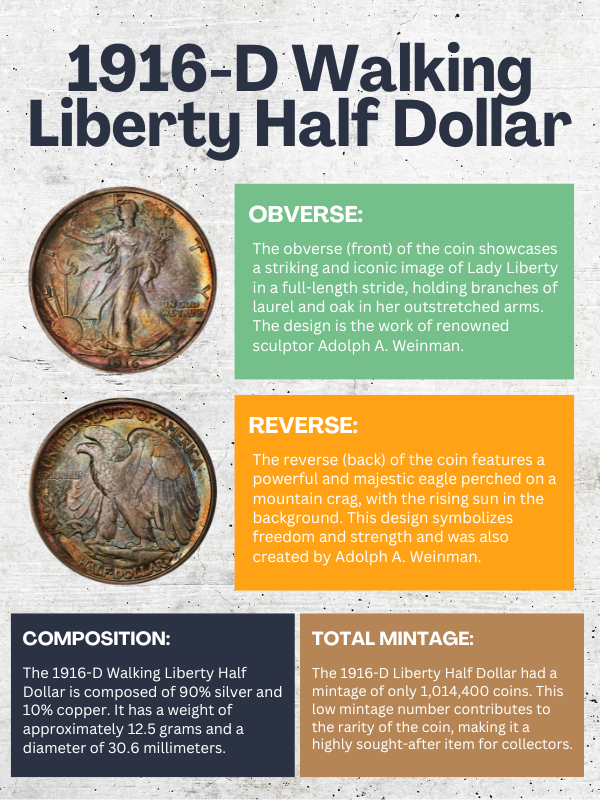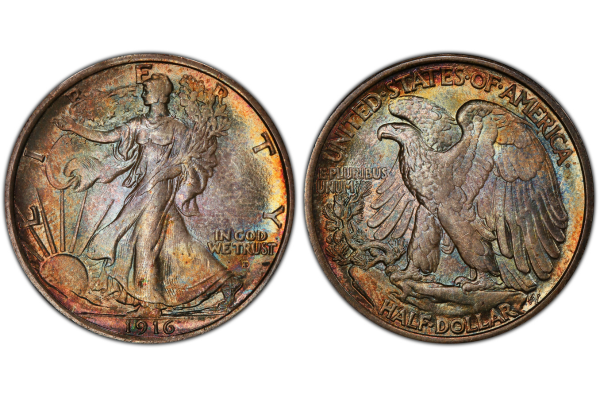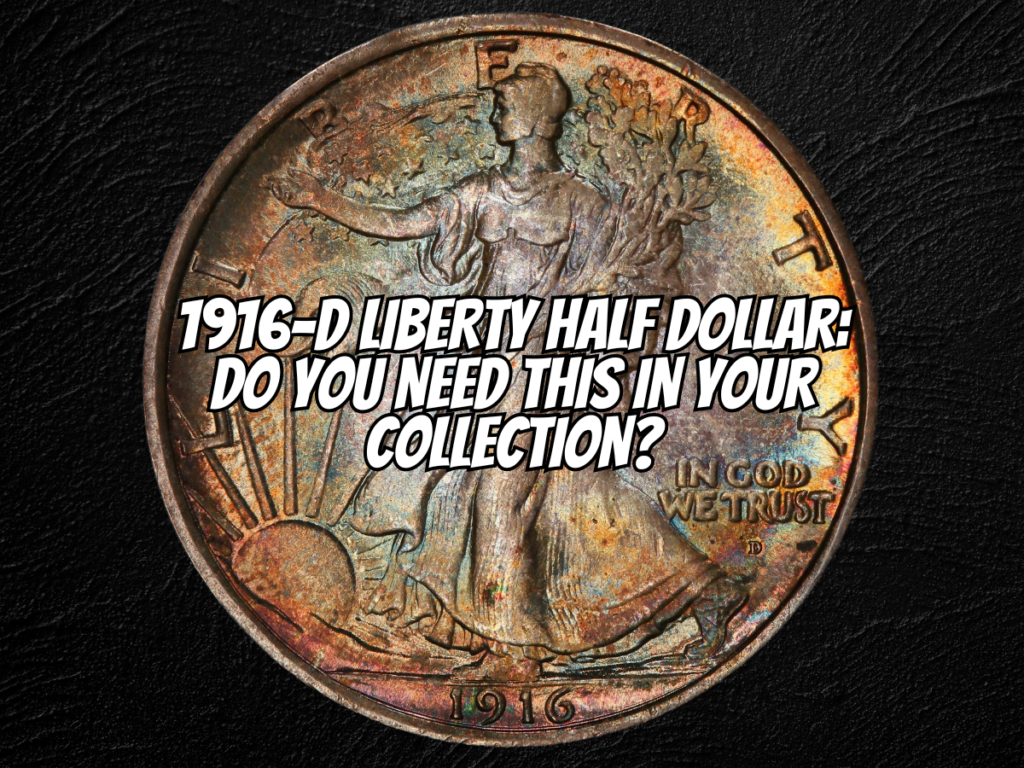The 1916-D Liberty Half Dollar stands as a prized gem among coin collectors, not just for its age but for its historical significance and rarity. Minted during a time of profound change in the United States, this coin reflects the artistry and craftsmanship of a bygone era.
I’ve always been fascinated by the stories coins can tell, and the 1916-D Liberty Half Dollar is no exception. It’s more than just a piece of currency; it’s a tangible link to the past, offering a glimpse into the economic and cultural landscape of early 20th-century America.
Key Takeaways:
1. The 1916-D Liberty Half Dollar is a highly sought-after coin among collectors and investors.
2. Its rarity and historical significance contribute to its value and appeal.
3. The 1916-D Liberty Half Dollar has significant investment potential for those looking to diversify their portfolio.
The 1916-D Liberty Half Dollar

The 1916-D Liberty Half Dollar, minted by the Denver Mint (D), embodies a significant era in American numismatics. Adolph A. Weinman designed both the obverse and reverse sides, featuring his meticulous craftsmanship. This 50-cent piece consists of silver, reflecting the economic standards of its time.
The obverse showcases Liberty adorned with a Phrygian cap and accompanied by olive branches. This design evokes themes of freedom and peace. Weinman’s initials, “AW,” subtly appear at the hem of Liberty’s gown, showcasing his personal touch.
The reverse side displays an eagle perched on a mountain pine, symbolizing strength and longevity. The inscriptions “E PLURIBUS UNUM” and “UNITED STATES OF AMERICA” frame the majestic bird.
The value of a 1916-D Liberty Half Dollar depends on several factors. These include the number of coins minted, the number of surviving coins, and collector demand.
In its historical context, this coin connects collectors to the early 20th century, an epoch marked by significant socio-economic shifts.
Owning a 1916-D Liberty Half Dollar isn’t just about possessing a piece of silver; it’s about holding a fragment of American history, rich with stories of liberty and resilience.
Rarity and Distribution

The 1916-D Walking Liberty half dollar had a mintage of 1,014,000 coins, making it rare, especially in mint state condition. Notable for its high-relief design, the coin often wore down, adding to its scarcity in higher grades.
Worn examples are relatively easy to find, yet mint state samples are particularly elusive.
The coin’s scarcity isn’t just about minting volume. The Mint faced production issues and high demand, exacerbating the limited release.
Each person could initially only buy two coins, reflecting the tight distribution constraints. These factors catapulted the coin to one of the scarcer dates in the series, alongside the 1921 and 1921-D issues.
Additionally, the distribution of the 1916-D Liberty Half Dollar was limited due to the low mintage number and the fact that it was only produced in Denver. This means that the coin is not as widely available as other coins from the same period.
Collectors value the 1916-D Walking Liberty at half a dollar. Its early release in limited quantities and the intrinsic design flaws contribute to the difficulty in finding mint-state versions today. The mint’s struggle to meet public demand emphasizes its place in numismatic history.
Current Market Value
| Grades | Price as of July 2024 |
|---|---|
| Good (G-4) | $50 |
| Very Good (VG-8) | $72 |
| Fine (F-12) | $102 |
| Very Fine (VF-20) | $207 |
| Extremely Fine (EF-40) | $254 |
| About Uncirculated (AU-50) | $296 |
| Uncirculated (MS-60) | $742 |
| Brilliant Uncirculated (MS-63) | $1,165 |
Collectors gravitate toward higher grades since they represent the pinnacle of preservation, allowing a clearer glimpse into the past. These values reflect the coin’s age, rarity, and historical significance, making the 1916-D Walking Liberty Half Dollar a prized addition to any collection.
Auction Records

I researched the auction records for the 1916-D Liberty Half Dollar and found that it has a high value among collectors.
NGC Auction Prices
The NGC Price Guide showcases auction prices realized for the 1916-D Walking Liberty Half Dollar across various grades. For example, a coin graded MS-64 might fetch $8,000, while a VG-8 example could sell for around $300.
PCGS Auction Prices
According to PCGS, a 1916-D Liberty Half Dollar in MS67 condition was sold for $54,000 in a Heritage Auctions event in September 2020. This is the highest auction record for this coin.
The rarity and condition of the coin significantly affect its value. In 2016, a superb 1916-D Liberty Half Dollar was sold for $1.527 million at an auction. This coin was graded PCGS MS67 Full Head and was considered one of the finest known examples of the 1916-D Liberty Half Dollar.
The 1916-D Liberty Half Dollar is also popular among collectors because it is the first year of issue for the Walking Liberty Half Dollar series. This adds to the coin’s historical significance and rarity, making it highly sought after.
The 1916-D Liberty Half Dollar is a valuable coin that commands high prices at auctions due to its rarity, condition, and historical significance. Collectors should keep an eye out for this coin and consider adding it to their collection if they have the opportunity.
Investment Potential

Considering its historical significance and rarity, the 1916-D Liberty Half Dollar stands out as a valuable addition to any collection. As auction results have shown, coins in superior grades can fetch impressive prices, making them a solid investment.
Collectors and investors alike should keep an eye on market trends and auction outcomes to make informed decisions. The enduring value of this coin highlights its appeal and potential for future appreciation.
Whether you’re a seasoned collector or new to the hobby, the 1916-D Liberty Half Dollar offers a unique opportunity to own a piece of history with substantial investment potential.
Before you go…
Overall, the 1916-D Liberty Half Dollar is a valuable and significant coin for collectors and enthusiasts alike. Its historical significance and rarity make it a prized addition to any collection.
Check out my next article: “Is the 1851-O Three Cent Silver a Rare Coin?“
Related Articles:

